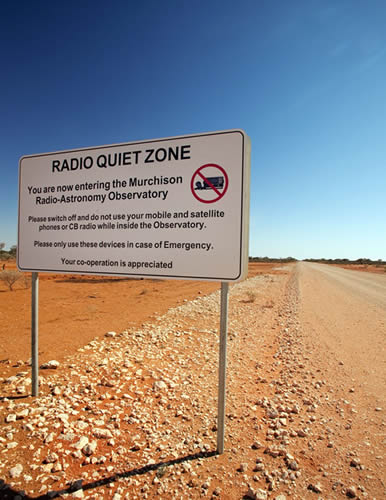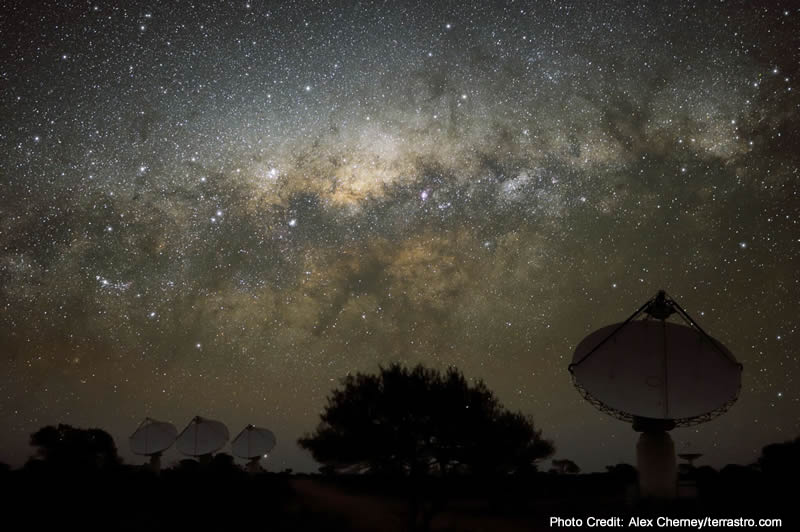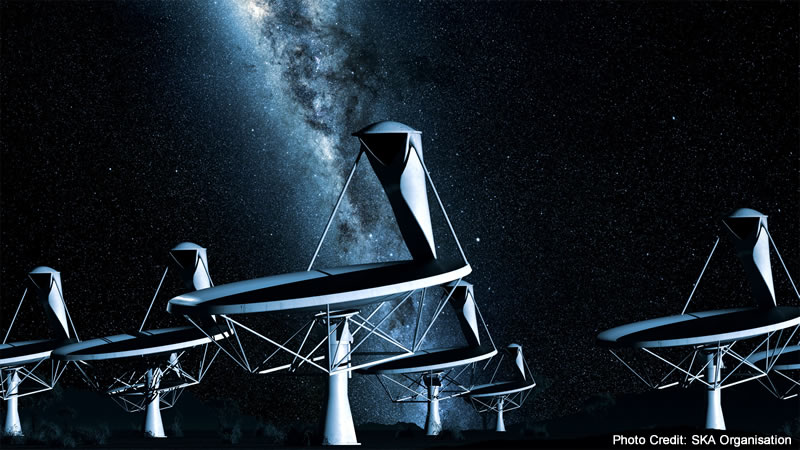HOMER Pro, the microgrid optimization platform, has been playing an important role in deploying one of the most ambitious science projects ever conceived: The Square Kilometer Array (SKA). The Square Kilometer Array is a massive radio telescope co-located in Australia and South Africa, an international collaborative effort designed to give astronomers a glimpse of the earliest era in the formation of the universe, the billion year period after the Big Bang. The environmental requirements for the project, including radio silence and several extremely remote, off-grid desert locations, led project designers to use HOMER Pro to evaluate options for powering the radio telescope arrays.
In the making for the past twenty-five years, the Square Kilometer Array is being implemented in phases because of the extraordinary scale and complexity of the project. The SKA will use thousands of dishes and up to a million antennas, and will cover over a million square meters of land – hence the name. It is being funded and managed by a consortium of more than 100 organizations from over 20 countries. According to Professor Robert Braun, Science Director of the SKA Organization, “We will…observe one of the last unexplored periods in the history of our Universe…looking back to the first billion years…when the first stars and galaxies are forming.”

Murchison Radio-astronomy Observatory
SKA Telescopes Co-Located in Australia and South Africa
The telescopes contributing to the SKA are located in two areas, the harsh desert outback of Western Australia, and South Africa’s equally remote and undeveloped Karoo region. One reason for these locations is the clear quality of the atmosphere above the desert sites; another is the requirement for absolute radio silence, a difficult thing to achieve these days on a planet awash with cell phone, radar, microwave, and other wireless signals.
While South Africa’s Karoo desert will host the mid-frequency dishes, ultimately extending over the African continent, Australia will host the High Frequency survey telescope and the low-frequency Aperture Array radio telescope, a widespread array that will be composed of up to a million antennas. These look a bit like Christmas trees, standing about two meters high with the electronics in a compartment at the top. Both countries have completed precursor projects to test telescope design, location and logistics, and Australia’s Murchison Radio-astronomy Observatory – where its SKA1 will be built – has already evolved into a world-class radio astronomy center.
The design of Australia’s portion of the SKA project – the high frequency survey telescope and the low-frequency aperture array – reflects an evolving science in radio telescopes, which use large numbers of small dishes that are relatively inexpensive to manufacture, instead of large individual telescopes. Spread out over immense areas of the landscape, the SKA1 array can increase its capabilities by simply adding more antennas, designed to pick up signals over a wide range of radio frequencies.
Linked together through sophisticated signal processing equipment and super-computers, the antennas effectively function as one large telescope in a process known as radio interferometry. The SKA is sensitive enough to be able to detect the equivalent of an airport radar on a planet that is millions of light years away. When complete, the Square Kilometer Array telescopes will produce massive amounts of data,10 times the current global internet traffic.
HOMER Pro Provided Power Options for Australia’s Remote Radio Astronomy Observatory
Horizon Power, a regional electricity utility owned by the government of Western Australia, was tasked with researching power supplies for Australia’s radio telescope facility starting in 2008. Servicing the largest area with the fewest customers in the world, Horizon Power has ample experience providing power in logistically challenging locations. Nonetheless, the complex power requirements for the extremely remote, off-grid, radio-quiet Murchison Radio-astronomy Observatory are daunting.
So far Horizon Power has followed an iterative process, using HOMER Pro to evaluate dozens of basic power scenarios – modeling various loads and their corresponding power options. As Horizon Power provided HOMER-generated cost estimates to the scientific community, scientists would fine-tune their project designs, whittling down their requirements and costs, and Horizon Power would refine their power plans.
Horizon Power’s David Edwards (who claims the job title of “Technical Visionary”) was in charge of researching the power supply challenge. He says the flexibility of HOMER Pro was vital to improving efficiency, coordination and cost-effectiveness of the planning process. “HOMER Pro works out the early stage options to find what’s feasible,” says Edwards.
First, Edwards’ team had to take into account the fact that the area where the telescopes would be located had no power lines, no gas pipelines, or nearby power stations. Everything had to be designed from scratch.
Then there was the challenge of how to deliver power to the observatory in an environment where nothing could interfere with the reception of the radio telescopes. The radio quiet requirement meant no cellphones, refrigerators, or other cooling equipment, no cameras, computers, gasoline engines or frequent diesel deliveries. Also, how could Horizon Power ensure radio quiet while providing cooling and maintenance for diesel or natural gas generators? To add to the complexity, summer temperatures routinely exceed 113º F (45º C) in the shade at the Murchison Radio-astronomy Observatory.
How would Horizon Power minimize the carbon footprint of the observatories, another project goal? And finally, should the power production facilities be built close to the load, with proper shielding for radio frequency interference (RFI), or located at sufficient distance that the shielding would not be necessary?
Edwards’ team analyzed numerous diesel and natural gas generator options in HOMER Pro, plus multiple configurations with wind, solar, and batteries to see how that would affect fuel costs. He surveyed local power sources at the nearest Aboriginal outposts, studied the proximity of pipelines and power lines – all of which were at extreme distances – estimated costs of pipelines for delivering gas and tankers to deliver diesel fuel, and calculated the costs of shielding equipment to prevent radio interference.
All of these options and models evolved iteratively as the telescope design and resultant power requirements edged their way to a cost-effective balance between CAPEX/OPEX and science outcomes.
Hybrid Renewable Energy System and Diesel Chosen to Power Australian Observatory
Considering all the complex factors at play, planners ultimately decided on locating a main power station at sufficient (10 km) distance from the telescope array to avoid the radio interference problem. It was just too expensive to provide RFI shielding for the power equipment. The initial power plant was solar/diesel, and now a 1.6 MW solar array and a 2.6 megawatt battery system has been added. These systems can be expanded when the low-frequency SKA telescope is built out to its full specifications.
Edwards says that there is now actually power in reserve, because the project has not yet met the originally projected load profile. So there is room for it to grow. Meanwhile, he says, he gave the HOMER Pro results to the SKA international headquarters in Manchester, UK. They were thrilled with the results and provided Horizon Power with a letter of commendation for their work.
What is the Square Kilometer Array looking for?
Now that the power challenge has been solved – at least for the moment – what can we expect from the Square Kilometer Array?
Professor Philip Diamond, Director General of the SKA Organization, says, no less, that “The SKA will fundamentally change our understanding of the Universe.”
The SKA telescope will be powerful enough to detect very faint radio signals emitted by cosmic sources billions of light years away from Earth, signals emitted in the first billion years of the Universe. So, in effect, it could provide us with 13 billion years of cosmic history. Scientists anticipate the SKA will allow them to observe pulsars, black holes, and distant galaxies with greater sensitivity than ever before, detect the gravitational waves predicted by Einstein, and look for “signatures of life in the galaxy,” according to Professor Braun.
Because the SKA will be able to measure interstellar hydrogen gas, it’s expected to provide insights into dark matter and help clarify the identity of dark energy, which, astronomers believe, is driving the expansion of the universe at an accelerating rate. Once completed, at some point in the early 2030s, the SKA is expected to be able to operate for the next 50 years.




